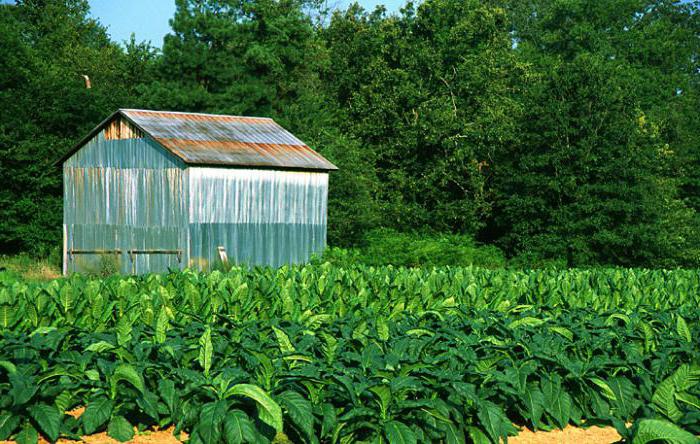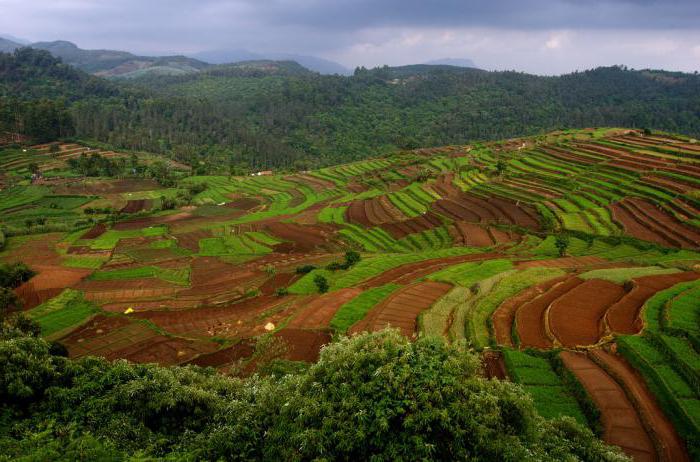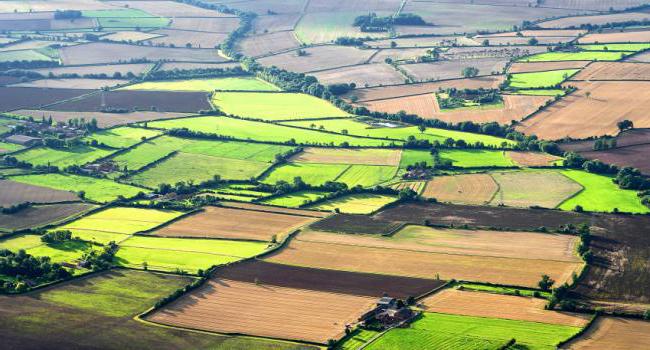Land use is a twofold concept. On the one hand, it represents a set of rules and laws aimed at the lawful use of land funds, and on the other hand, the disposal of land activities and the exploitation of land through their own or wage labor. The rules of land use and development of cities, towns and districts are regulated by state laws, and the land user, unlike the owner of the land, has a limited range of rights. This and much more will be discussed below.
Summary
The method of using land funds is of great importance both in the development of the agricultural economy of the state, and in social terms. The total number of products produced by individual business units grows when the landowner is interested in the results of his work or the work of his wards. At the same time, the dominant land use of the state determines the distribution of citizens' incomes from land ownership in various social classes.

Forms
The forms of land use are classified into:
- Slave economy;
- Personal use;
- Hired labor or laborers;
- Serfdom;
- Cowgirling or renting.
History reference
Land ownership has long been considered a key form of capital. She gave the owner not only a livelihood, but also power. Owning land could only be a full citizen of the state in which it is located. In conquered countries, land holdings were divided between the highest or military ranks of the conquering country. The population of the divided lands became slaves or serfs, who, as a rule, were engaged in the cultivation of this same land for their master.
Feudalism
Feudal land holdings were classified as follows:
- Allod is the property of a large family, which must necessarily be inalienable and inseparable.
- Feod - territories that the lord granted the vassal to the hereditary possession, provided that the vassal will conscientiously carry out the court, military or administrative service with the lord.
- The ordinate is the hereditary transfer of land holdings to the tycoon-ordinate, his eldest son, as indivisible and inalienable property.
- Freehold - a lifetime or hereditary possession, in England of the Middle Ages.
- Almenda - land in Western Europe of the Middle Ages that are in common use (not shared) of all members of a particular community. Such lands could include: forests, meadows, wastelands, ponds, and more.
- Easement - a limited right to use someone else's land.
- Editing - land rent, the payment for which was equal to the previously agreed share of the crop received from it.
- Uspolshchina - a variant of shareholding, the rent at which is equal to half the crop.

Related concepts
Consider the basic concepts that we may encounter when discussing the features and rules of land use.
Land user - a person (natural or legal) who has the right to use the land. It can be unlimited, long-term or temporary.
Land lease - a form of land use, which assumes that the owner of the site provides the right to use it to another person for a certain fee, for a certain period.
Land easement - a type of property right to land, which assumes that persons who are not owners of the land can use the land in the manner specified in the agreement. Typically, the easement is used in cases where you need to get the right to travel or pass through someone else's site, or laying pipelines and other communications through it. In this case, the owner of the land retains the right to use and dispose of his plot.
Land management - A set of measures aimed at regulating land use and organizing the protection of land. It is the totality of land management measures that makes land use orderly and opens up opportunities for the introduction of new farming systems.
Permitted use of land - A complete list of tasks that can be solved on a specific plot of land. Compiled on the basis of the zoning scheme of the territory.
Land User Registration - an entry in the land register and the state land cadastre on the rights of legal entities and individuals with respect to a particular plot of land. This record has the established content and is the main title document. Registered lands receive guaranteed government protection.
Agricultural land - land located outside the settlement and presented for the implementation of agricultural needs.

Land classification
Land use is a form of management and disposition of land in order to derive profit or useful properties from them. Land use can be implemented by:
- Rational organization of territories;
- Free housekeeping;
- Protection of land funds from destructive and polluting factors;
- Use of minerals found in a particular area;
Land use rules are strictly stipulated in the relevant legislative acts.
The category of land is called part of the unified state land fund, which is allocated for the main purpose. The category of land always has a certain legal regime. According to the functional purpose of the land there are:
- Agricultural purpose.
- Territory of settlements.
- Transport, industrial and other similar purposes.
- Historical, cultural, environmental and recreational fund.
- Forest Fund.
- Water fund.
- Land stock.
Agricultural land
Agricultural lands are the main and most large-scale object of land-user relations, so they should be considered separately. Agricultural lands include not only agricultural land, but also territories on which:
- Communications.
- On-farm roads.
- Trees and shrubs, designed to protect land from negative man-made, man-made and natural phenomena.
- Closed reservoirs.
- All kinds of buildings and structures used for storage and processing of agricultural products.
Agricultural land is called plots of land used for agricultural production. The lands are divided into: perennial plantations, arable land, hayfields and pastures. They can also be irrigated and non-irrigated.

Pastures
Pastures deserve special attention. They are patches of land with grassy vegetation that are regularly used for grazing herbivores. Prior to the spread of agricultural mechanization, pastures served as the main food source for horses and cattle. Pastures to this day are used for grazing animals, especially in those regions where, due to the arid climate, the land is not suitable for other types of agricultural production.
By the type of relief, pastures are divided into: dry, boggy, flooded and others. And according to the degree of processing - cultural and natural. Cultivated pastures are created by planting grassland with high nutritional value.
Land management
Land use is a fairly dynamic process. The fact is that land resources are constantly undergoing quantitative and qualitative changes associated with the inevitable depletion of land, a change in its use and the impact of various natural processes. Hence, the need arises for fixing all the changes, and making timely adjustments to the accounting, registration and appraisal documents, which are the basis of the cadastral system and ensure effective management of land funds.
Effective management means organized land use adapted to economic, social, and, of course, environmental conditions. The rules of land use and building settlements should take into account all the features of a particular plot of land. In the practice of land use, such concepts as rational and optimal land use also appear.
Optimal land use and development involve the use of the maximum functional potential of land, which is possible in specific natural conditions, at minimal cost, without negative consequences. Practice shows that the implementation of this approach is unlikely, since any invasion of the environment, even if it leaves no visible traces, leads to a change in the natural situation.

Rational rural and urban land use is a more realistic concept. It assumes that in the production process all land users will achieve the greatest effect in achieving their goals, taking into account considerations of land protection and optimal interaction with nature. Irrational land use is expressed in:
- Misuse of land.
- Use, which leads to reduced fertility and land depletion.
- Use, which leads to environmental degradation.
Thus, rational land use is the use of the maximum possible functional potential of the land at minimum cost and preservation of fertility.
Land Allocation Standards
In addition to caring for the environmental situation and preserving fertility, land allocation standards are also taken into account. The rules of land use and development of rural settlements imply compliance with quantitative and qualitative criteria for rational use. Quantitative criteria include the economical use of land and the same economical placement of real estate on it. Qualitative criteria include:
- Preservation of the fertile layer, if necessary, destruction of the soil.
- Restriction on the use of agricultural land for non-agricultural purposes.
- Increasing soil fertility as a land user obligation.
- Soil protection from pollution, contamination and erosion.
- Allocation for non-agricultural needs of lands that are not suitable for agricultural activities.

Agricultural expansion
The land use rules of rural settlements are based on the priority of agricultural land. Therefore, the expansion of areas for growing crop products should be encouraged by the government. The main thing is that this expansion does not contradict the rule prohibiting exceeding the maximum permissible load on the environment.
Land use rationality indicator
This indicator consists of two components. The first is the correct selection of the priority function of a particular site.And the second is the presence of a limiting factor that impedes the implementation of priority or most productive functions.
The priority function is none other than the targeted use of land. This factor is unstable, it can fluctuate, depending on changes in the ecological, economic or any other situation. An example of this is the seizure of land and a change in its intended use in connection with road, communication or construction work, the expansion of green areas, and so on. The rules of land use and development of the district suggest that in case of a change in the type of land user’s activity, the owner of the site must be aware of this, and if he can suffer losses, they must be compensated.
Limiting factors are called soil properties that reduce its functional potential. To them, in addition to climatic factors, include: topography, overlapping, shallow contour, a high level of variegation of the soil cover and the like. Moreover, it is the relief that is the most important factor determining the land use of rural settlements.

Non-registered land use
There are examples of unregistered use of land that are not always considered self-capture. In this case, use the concept of "spontaneous land use", which means the use of land without the knowledge of the landowner and the preparation of relevant documentation. An example of spontaneous land use can be: tourism, the development of land for vegetable gardens, the use of undeveloped mineral springs, and more.